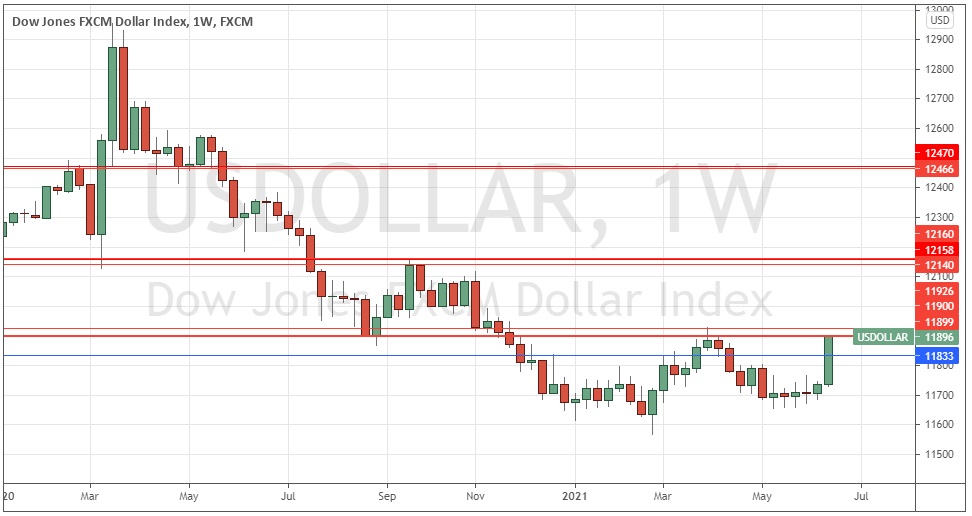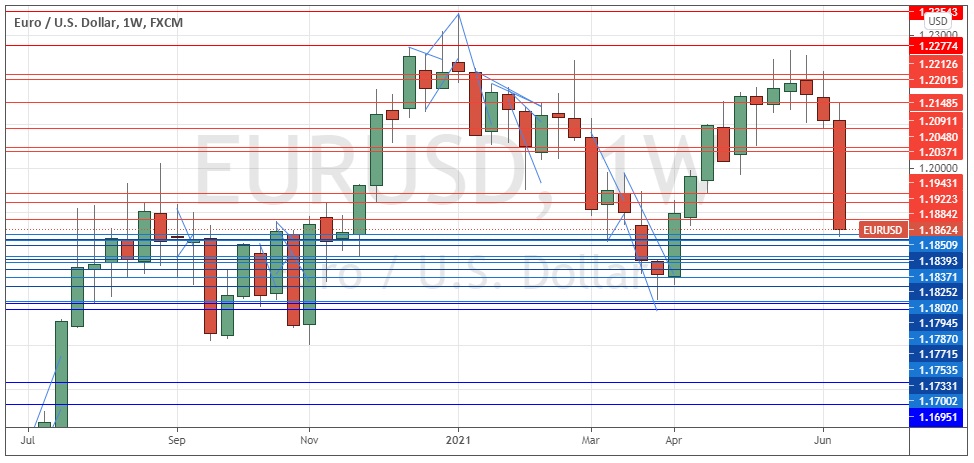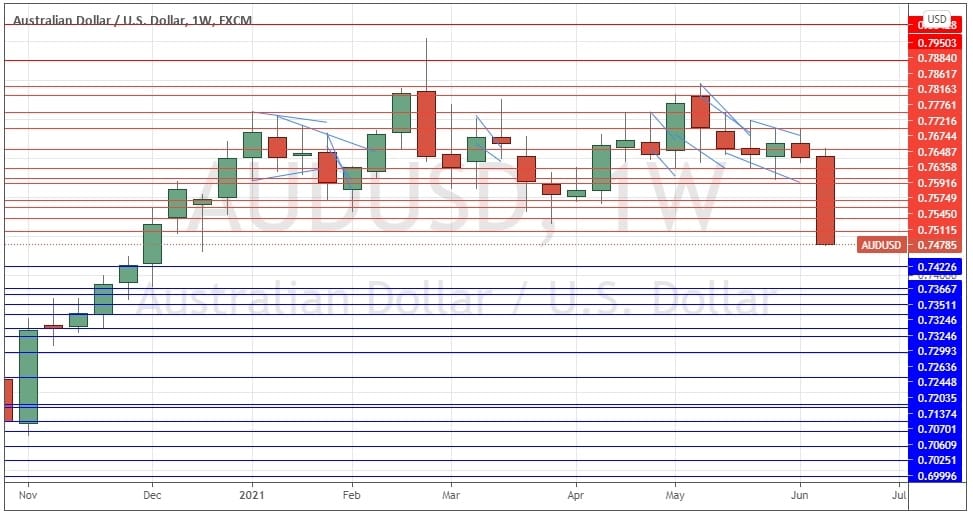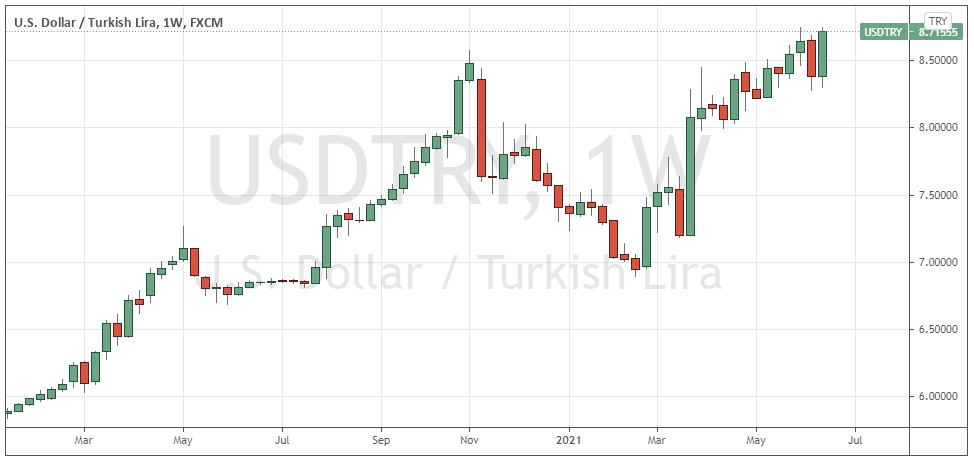The difference between success and failure in Forex trading is very likely to depend mostly upon which currency pairs you choose to trade each week and in which direction, and not on the exact trading methods you might use to determine trade entries and exits.
When starting the trading week, it is a good idea to look at the big picture of what is developing in the market as a whole and how such developments and affected by macro fundamentals and market sentiment.
It is a great time to be trading markets right now, as there is strong short-term momentum in several areas triggered by a major central bank announcement – the U.S. Federal Reserve’s Economic Projection, which saw sharp upwards revisions in anticipated inflation, interest rates, and GDP over the near to medium term. This has caused the U.S. dollar and Japanese yen to strengthen considerably on strongly higher volatility, while the “asset bubble” commodity currencies (CAD, AUD, NZD), as well as European currencies, were hardest hit. Although these movements are not truly in the context of a supportive long-term trend, they are dramatic enough to look likely to follow through for a few days at least.
Big Picture 20th June 2021
Last week’s Forex market saw the strongest rise in the relative value of the U.S. dollar and the strongest fall in the relative value of the Canadian dollar. Volatility in the Forex market rose sharply after the FOMC release on Wednesday.
I wrote in my previous piece last week that the best trades were likely to being long of the S&P 500 Index following a daily (New York) close above 4250, and of being long WTI Crude Oil. Unfortunately, the S&P 500 Index ended the week down by 2.08% after closing above 4250, while WTO Crude Oil is higher by 0.88% over the week, giving an averaged loss of 0.60%.
Fundamental Analysis & Market Sentiment
The headline takeaway from last week was the market’s surprise of the extent at the speed at which inflation is gaining pace in the U.S. coupled with rate hikes now looking likely to begin in 2023. This initially boosted the U.S. dollar but then prompted a flow into the Japanese yen as well, while stocks and commodities (and the commodity currencies of course) took a dive. European currencies also fell sharply, especially the NOK and SEK. So, the key takeaway is a rise in risk aversion more than a boost for the greenback, although it looks likely that the U.S. dollar will enjoy some momentum for a while longer after gaining so sharply.
Last week also saw a quarterly policy release from the Swiss National Bank which contained no surprises or rate adjustments and had little impact on the Forex market. There were also data concerning Canada, New Zealand, and Australia, but these were completely overshadowed by the big moves going on in these currencies or otherwise had little effect.
The main events this coming week will be testimony before the U.S. Congress from the Chair of the Federal Reserve on Tuesday and the Bank of England’s monthly policy release on Thursday.
Last week saw the global number of confirmed new coronavirus cases and deaths fall for the seventh week running, suggesting that the most recent wave which saw a new record daily high has peaked globally. It is likely that the extensive vaccination campaigns seen mostly in more advanced economies has contributed significantly to this situation. Approximately 21.1% of the global population has received at least one vaccination to date.
Excepting extremely small nations, the fastest progress towards herd immunity has taken place in Iceland, Kuwait, Canada, Israel, Bhutan, the U.K. and Chile, which have each inoculated more than 62% of their respective populations. Immunization is now proceeding more quickly in the European Union than it is in the U.S. although the U.S. is ahead of the E.U. with 53% of its population having received at least one shot of a vaccine, while the E.U. has vaccinated 47% of its population. A few nations have begun vaccinating older children, but this is mostly being done on only a limited basis.
The strongest growth in new confirmed coronavirus cases right now is happening in Bangladesh, Brazil, Colombia, Cuba, Fiji, Indonesia, Iraq, Kyrgyzstan, Mongolia, Oman, Panama, Russia, South Africa, Tunisia, and the U.K. The U.K.’s case seems unusual as it has such a high vaccination rate, although the under-30s within Britain’s ageing population are still largely unvaccinated.
Technical Analysis
U.S. Dollar Index
The weekly price chart below shows the U.S. Dollar Index printed a very large bullish candlestick last week which closed right on the high of its range. Last week saw the strongest rise in the US Dollar Index since March 2020. These are bullish signs, as is the fact that the index is finally above its prices from both six and three months ago, which shows that a long-term bullish trend in the greenback has now been established. Overall, next week’s price movement in the U.S. dollar looks more likely to be upwards than downwards. This suggests that trades long of the USD against other currencies are most likely to be appropriate over this coming week.
EUR/USD
The EUR/USD currency pair printed a strong, large bearish candlestick last week which closed very near its low. This was the largest weekly downwards movement in this currency pair in almost one year. These are bearish signs, as is the fact that the EUR/USD currency pair is finally below its prices from both six and three months ago which shows a new long-term bearish trend has begun. The price is not far from a zone which may act as strong support, but the strong bearish momentum is likely to see some follow-through over the coming days.
AUD/USD
The AUD/USD currency pair printed a strong, large bearish candlestick last week which closed right on its low. This was the largest weekly downwards movement in this currency pair in nine months, and the close is at a six-month low price. These are bearish signs, as is the fact that the AUD/USD currency pair is now below its prices from both six and three months ago which shows a new long-term bearish trend has begun with a strong breakdown. The strong bearish momentum is likely to see some follow-through over the coming days. The AUD tends to be more heavily hit by global economic pessimism than any other risk currency, so should be interesting to Forex traders right now in the current environment.
USD/TRY
The USD/TRY currency pair printed a strong, relatively quite large bullish candlestick last week which closed quite near its high at an all-time high weekly closing price. These are bullish signs, boosted by the fact that the USD is the strongest major currency, while the Turkish lira is a basket case subject to endless long-term depreciation due to a lack of confidence in the ability of Turkey’s central bank to operate effectively. These two factors make longs attractive here, but traders should always beware of high spreads and even higher volatility, with the pair prone to strong pullbacks even within strong trends.
Bottom Line
I see the best likely opportunities in the financial markets this week as being short of the EUR/USD currency pair until there is an end of day close at a new two-day high, and I would do the same with AUD/USD. Traders may also find short-term opportunities going long on the USD/TRY currency pair.





